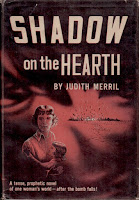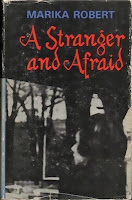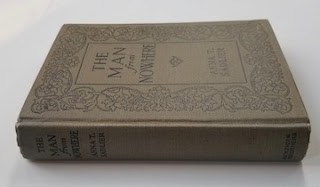The Man from Nowhere
Anna T. Sadlier
New York: Benziger Bros, 1918
187 pages
Has anyone out there read Anna T. Sadlier? If so, can you tell me whether
The Man from Nowhere is typical of her novels? Do you know it?
Here's a summary:
Brothers Harry and Fred Tremaine are spending the summer at the family's seaside villa, outside an unnamed village not far from their New York City home. As Mr and Mrs Tremaine are holidaying abroad, the boys are in the care of former nursemaid Hannah, who now serves as housekeeper. Coachman Mike is on standby, and will come in handy as the action begins.
Harry and Fred are on the beach, digging a sand tunnel, as young locals Bill Masterton and Paddy Wallace look on. It's Ben who sets the plot in motion:
“Paddy, look out yonder!”
Paddy looked and uttered an exclamation:
“Cricky, Ben!” he cried, “it’s a boat, a
catboat, I guess, and what — "
He said no more, but ran with a quick,
instinctive movement down to the water’s
edge.
“It’s bottom upward!” he cried, “that’s
what it is.”
“By Jingo!” was all Ben said, as he strode
after his friend. By mutual consent, they
seemed to ignore the city boys, who could
not be expected to know anything of such
an emergency.
Ben takes charge, dispatching Paddy and the Tremaine brothers to help round up the crew of the local lifeboat. The craft sets out for the overturned vessel, upon which balances a desperate man.
Father McNeirny shows up to comfort the anxious amassing crowd. When a wave hits, sweeping the desperate man out of sight, the priest offers conditional absolution.
The man resurfaces, is rescued by the lifeboat, and Mike rushes him to the Tremaine summer villa. Hannah has prepared a bed in which, exhausted, the rescued man sleeps soundly as the four boys keep watch. When he awakens, he toys with the boys' fears that he might be a thief looking to make off with the Tremaine family silver, and then sets out on a walk from which he never returns.
During the remainder of the summer, the village experiences some very strange happenings. The first occurs when Harry, Fred, Ben, and Paddy come upon a food hamper, clearly left for them, at the end of a crabbing expedition.
The others are tied to Father McNeirny's annual picnic, at which "it was jestingly
suggested that those present should severally
or individually put their wishes upon record,
and a secretary was actually chosen for the
purpose."
You know, the usual picnic pastime.
Next thing you know, the wishes are fulfilled. Ben receives a complete fishing kit, Paddy is sent fifty dollars, Hannah gets a silk dress, and the village is given an anonymous donation to be used in the construction of a community hall. Most important of all, Father McNeirny receives a new set of vestments in anticipation of the bishop's next visit.
Who might be the source of all this magnificence?
Can you guess?
Why, it's the man who was rescued from the sea!
Turns out that he's a famous billionaire who had become a recluse following the untimely deaths of his wife and children. The great reveal is provided by Father McNeirny:
"What I have
to tell you first is deeply shocking, especially to our Catholic instincts. Boys, he went
out there into those waves with the deliberate purpose of destroying himself.”
Exclamations of horror broke from the
lads. The Tremaines particularly, in their
sturdy and enlightened Catholicity, felt loathing of that capital crime, that unpardonable sin, which done deliberately, makes
even the mercy of a Redeeming God unavailable.
But, of course, the boys' good work helped save the wealthy man from eternal damnation.
And now, the billionaire has decided to convert to Catholicism.
Huzzah!
 |
from The World's Columbian Catholic Congresses and Educational Exhibit
(Chicago: J.S. Hyland & Co., 1893) |
The doctrinaire was expected. Before opening this book, I knew Anna T. Sadler to have been one of Canada's most popular religious novelists. I'd read others –
Margaret Murray Robertson,
Laure Conan,
W.H. Withrow,
Ralph Connor – but nothing prepared me for the religiosity of
The Man from Nowhere. Consider this passage, in which Father McNeirny grants the shipwrecked billionaire absolution:
“God bless you and do, Father,” cried an old woman, from whose aged eyes tears were streaming.
Every one waited respectfully. Even Protestants or other outsiders who had no hold whatever upon Christianity regarded him curiously. They drew a kind of comfort from the mysterious power which, as it was quietly whispered around, he was about to exert over that human soul which might be even then slipping from its bonds and losing its hold upon earthly life. The priest had with him the stole which he had but lately worn when administering the Sacraments to a dying person in the calm obscurity of a little inland village. He put this about his neck and knelt a moment in prayer, and the Catholics — of whom there were many present — knelt likewise, while others raised their hats or bent the knee, sympathetically. Fred and Harry afterward declared that they had never prayed so hard in their lives as then. After that slight pause the priest arose and said in a clear, distinct voice:
“By the power which the Church confers upon her ministers, the power derived from Christ, I am about to give this man conditional absolution.’’
There was a dead silence, broken only by a giant wave breaking upon the shore. The priest raised his hand and every one present, forgetting all controversial differences, was impressed by the tremendous power of the act.
“I absolve you,” he said in Latin, “from all sins, in the name of the Father and of the Son and of the Holy Ghost.” To which he added: “May the Almighty God have mercy on you and forgive you your sins and bring you to life everlasting. Amen.”
A kind of peace and quietness fell over the scene with the performance of that holy act. Women and even strong men, overcome by the solemnity of the occasion, wept audibly, while the priest, sinking once more upon his knees, prayed aloud and begged the people to pray for the rescue of the unhappy being thus buffeted by the waves or for the salvation of his soul. The air seemed to vibrate with those burning words of supplication wherein people of all creeds or of none felt impelled to join. It used to be said long afterwards in the village that the whole incident was better than twenty sermons and it brought back more than one stray sheep to the fold. It showed the relative values, the little space which divides time from eternity and made every one realize, with a strange new force, the almost infinite power of the priesthood.
I ask again, has anyone out there read Anna T. Sadlier? Is this typical of her novels?
If so, I won't bother reading another.
If not Sadlier, should I try Janette Oke?
Object: I see evidence of two printings: one in red cloth, the other in olive. My (olive) copy includes a twelve-page list of "BOOKS OF DOCTRINE, INSTRUCTION, DEVOTION, MEDITATION, BIOGRAPHY, NOVELS, JUVENILES, ETC. PUBLISHED BY BENZIGER BROTHERS." Amongst its five hundred or so titles, I spot a dozen by Sadlier:
Names That Live in Catholic Hearts,
Women of Catholicity,
The Pilkington Heir,
The Red Inn of St. Lyphar, The True Story of Master Gerard,
Mary Tracy's Fortune, The Mysterious Doorway,
The Mystery of Hornby Hall,
Pauline Archer,
A Summer in Woodville,
The Talisman, and my favourite title,
Wayward Winifred.
Access: All of three copies are listed for sale online, the least expensive – US$12.00 – being a first edition. At US$35.00, the most expensive, claimed to be a first edition (in olive boards), has a "slight musty odor." My advice is to purchase the cheapest.
Library and Archives Canada, the Toronto Public Library, and three of our university libraries hold copies.
The novel can be read
here –
gratis – courtesy of the Internet Archive.
Related posts:

























